The Comparison of InSb-Based Thin Films and Graphene on SiC for Magnetic Diagnostics under Extreme Conditions
Abstract
:1. Introduction
2. Materials and Methods
2.1. Samples Preparation
2.2. Fast Neutron Irradiation
2.3. Determination of the Electrical Parameters
2.4. Temperature Treatment
3. Results and Discussion
3.1. Type of Damage Induced by Fast Neutrons in the Investigated Materials
3.2. The Effect of NR on the Electrical Parameters of InSb and GR/SiC
3.3. Temperature-Induced Self-Healing of the Irradiated Systems
3.4. Discussion of Different Sensor Platforms
4. Conclusions
Author Contributions
Funding
Data Availability Statement
Acknowledgments
Conflicts of Interest
Abbreviations
| GR/SiC | Epitaxial Chemical Vapor Deposition graphene on semi-insulating silicon carbide. |
| InSb | Indium antimonide. |
| NR | Neutron radiation. |
| CVD | Chemical Vapor Deposition. |
| QFS | Quasi-free-standing. |
References
- Mahfoud, M.; Tran, Q.H.; Wane, S.; Ngo, D.T.; Belarbi, E.H.; Boukra, A.; Kim, M.; Elzwawy, A.; Kim, C.; Reiss, G.; et al. Reduced thermal dependence of the sensitivity of a planar Hall sensor. Appl. Phys. Lett. 2019, 115, 072402. [Google Scholar] [CrossRef]
- Dowling, K.M.; Alpert, H.S.; Yalamarthy, A.S.; Satterthwaite, P.F.; Kumar, S.; Kock, H.; Ausserlechner, U.; Senesky, D.G. Micro-Tesla Offset in Thermally Stable AlGaN/GaN 2DEG Hall Plates Using Current Spinning. IEEE Sens. Lett. 2019, 3, 2500904. [Google Scholar] [CrossRef]
- Satake, Y.; Fuji, K.; S, J.; Seki, T.; Tsukazaki, A. Fe-Sn nanocrystalline films for flexible magnetic sensors with high thermal stability. Sci. Rep. 2019, 9, 3282. [Google Scholar] [CrossRef] [PubMed] [Green Version]
- Ciuk, T.; Kozlowski, A.; Piotr, P.; Kaszub, W.; Kozubal, M.; Rekuc, Z.; Podgorski, J.; Stanczyk, B.; Przyborowska, K.; Jozwik, I.; et al. Thermally activated double-carrier transport in epitaxial graphene on vanadium-compensated 6H-SiC as revealed by Hall effect measurements. Carbon 2018, 139, 776–781. [Google Scholar] [CrossRef]
- Entler, S.; Soban, Z.; Duran, I.; Kovarik, K.; Vyborny, K.; Sebek, J.; Tazlaru, S.; Strelecek, J.; Sladek, P. Ceramic-chromium hall sensors for environments with high temperatures and neutron radiation. Sensors 2021, 21, 721. [Google Scholar] [CrossRef] [PubMed]
- Ongena, J.; Koch, R.; Wolf, R.; Zohm, H. Magnetic-confinement fusion. Nat. Phys. 2016, 12, 398–410. [Google Scholar] [CrossRef]
- Verberck, B. Building the way to fusion energy. Nat. Phys. 2016, 12, 395–397. [Google Scholar] [CrossRef]
- Ďuran, I.; Entler, S.; Kohout, M.; Kočan, M.; Vayakis, G. High magnetic field test of bismuth Hall sensors for ITER steady state magnetic diagnostic. Rev. Sci. Instrum. 2016, 87, 11D446. [Google Scholar] [CrossRef]
- Ďuran, I.; Entler, S.; Kočan, M.; Kohout, M.; Viererbl, L.; Mušálek, R.; Chráska, T.; Vayakis, G. Development of Bismuth Hall sensors for ITER steady state magnetic diagnostics. Fusion Eng. Des. 2017, 123, 690–694. [Google Scholar] [CrossRef]
- Kocan, M.; Duran, I.; Entler, S.; Vayakis, G.; Agostinetti, P.; Brombin, M.; Carmona, J.M.; Gambetta, G.; Jirman, T.; Marconato, N.; et al. Steady state magnetic sensors for ITER and beyond: Development and final design (invited) Steady state magnetic sensors for ITER and beyond: Development and final design (invited). Rev. Sci. Instrum. 2018, 89, 10J119. [Google Scholar] [CrossRef]
- Entler, S.; Duran, I.; Kocan, M.; Vayakis, G.; Kohout, M.; Sebek, J.; Sladek, P.; Grover, O.; Vyborny, K. Prospects for the steady-state magnetic diagnostic based on antimony Hall sensors for future fusion power reactors. Fusion Eng. Des. 2019, 146, 526–530. [Google Scholar] [CrossRef]
- Bolshakova, I.; Belyaev, S.; Bulavin, M.; Brudnyi, V.; Chekanov, V.; Coccorese, V.; Duran, I.; Gerasimov, S.; Holyaka, R.; Kargin, N.; et al. Experimental evaluation of stable long term operation of semiconductor magnetic sensors at ITER relevant environment. Nucl. Fusion 2015, 55, 83006. [Google Scholar] [CrossRef]
- Ďuran, I.; Entler, S.; Grover, O.; Bolshakova, I.; Výborný, K.; Kočan, M.; Jirman, T.; Vayakis, G.; Vasyliev, O.; Radishevskyi, M.; et al. Status of steady-state magnetic diagnostic for ITER and outlook for possible materials of Hall sensors for DEMO. Fusion Eng. Des. 2019, 146, 2397–2400. [Google Scholar] [CrossRef]
- Jankowski, J.; Prokopowicz, R.; Pytel, K.; El-Ahmar, S. Toward the Development of an InSb-Based Neutron-Resistant Hall Sensor. IEEE Trans. Nucl. Sci. 2019, 66, 926–931. [Google Scholar] [CrossRef]
- Ďuran, I.; Oszwaldowski, M.; Kovařík, K.; Jankowski, J.; El-Ahmar, S.; Viererbl, L.; Lahodová, Z. Investigation of impact of neutron irradiation on properties of InSb-based hall plates. J. Nucl. Mater. 2011, 417, 846–849. [Google Scholar] [CrossRef]
- El-Ahmar, S.; Szary, M.J.; Ciuk, T.; Prokopowicz, R.; Dobrowolski, A.; Jagiełło, J.; Ziemba, M. Graphene on SiC as a promising platform for magnetic field detection under neutron irradiation. Appl. Surf. Sci. 2022, 590, 152992. [Google Scholar] [CrossRef]
- Bolshakova, I.A.; Kost, Y.Y.; Radishevskyi, M.I.; Shurygin, F.M.; Vasyliev, O.V.; Wang, Z.; Neumaier, D.; Otto, M.; Bulavin, M.V.; Kulikov, S.A. Resistance of Hall Sensors Based on Graphene to Neutron Radiation; Springer Proceedings in Physics; Springer: Berlin/Heidelberg, Germany, 2020; Volume 244, pp. 199–209. [Google Scholar] [CrossRef]
- Oszwaldowski, M. Hall sensors based on heavily doped n-InSb thin films. Sens. Actuators A Phys. 1998, 68, 234–237. [Google Scholar] [CrossRef]
- Jankowski, J.; El-Ahmar, S.; Oszwaldowski, M. Hall sensors for extreme temperatures. Sensors 2011, 11, 876–885. [Google Scholar] [CrossRef] [Green Version]
- Ciuk, T.; Stanczyk, B.; Przyborowska, K.; Czolak, D.; Dobrowolski, A.; Jagiello, J.; Kaszub, W.; Kozubal, M.; Kozlowski, R.; Kaminski, P. High-Temperature Hall Effect Sensor Based on Epitaxial Graphene on High-Purity Semiinsulating 4H-SiC. IEEE Trans. Electron Devices 2019, 66, 3134–3138. [Google Scholar] [CrossRef]
- Oszwaldowski, M.; Slany, M. Flash evaporation of InSb on i-GaAs substrates. Vacuum 1992, 43, 617–618. [Google Scholar] [CrossRef]
- Oszwaldowski, M.; Berus, T. High temperature Hall sensors. Sens. Actuators A Phys. 2007, 136, 234–237. [Google Scholar] [CrossRef]
- Berus, T.; Goc, J.; Nowak, M.; Oszwaldowski, M.; Zimpel, M. Preparation and electrical properties of InSb thin films heavily doped with tellurium, selenium and sulphur. Thin Solid Film. 1984, 111, 351–366. [Google Scholar] [CrossRef]
- Berus, T.; Oszwaldowski, M.; Grabowski, J. High quality Hall sensors made of heavily doped n-InSb epitaxial films. Sens. Actuators A Phys. 2004, 116, 75–78. [Google Scholar] [CrossRef]
- Oszwaldowski, M.; Berus, T.; Borowska, a.; Czajka, R.; Zimniak, M. Growth of InSb thin films on GaAs(100) substrates by flash evaporation epitaxy. Phys. Status Solidi (C) 2004, 1, 351–354. [Google Scholar] [CrossRef]
- Ciuk, T.; Cakmakyapan, S.; Ozbay, E.; Caban, P.; Grodecki, K.; Krajewska, A.; Pasternak, I.; Szmidt, J.; Strupinski, W. Step-edge-induced resistance anisotropy in quasi-free-standing bilayer chemical vapor deposition graphene on SiC. J. Appl. Phys. 2014, 116, 123708. [Google Scholar] [CrossRef] [Green Version]
- Ciuk, T.; Strupinski, W. Statistics of epitaxial graphene for Hall effect sensors. Carbon 2015, 93, 1042–1049. [Google Scholar] [CrossRef]
- Ciuk, T.; Caban, P.; Strupinski, W. Charge carrier concentration and offset voltage in quasi-free-standing monolayer chemical vapor deposition graphene on SiC. Carbon 2016, 101, 431–438. [Google Scholar] [CrossRef]
- Dobrowolski, A.; Jagiełło, J.; Czołak, D.; Ciuk, T. Determining the number of graphene layers based on Raman response of the SiC substrate. Phys. E Low-Dimens. Syst. Nanostruct. 2021, 134, 114853. [Google Scholar] [CrossRef]
- Strupinski, W.; Grodecki, K.; Wysmolek, A.; Stepniewski, R.; Szkopek, T.; Gaskell, P.E.; Gruneis, A.; Haberer, D.; Bozek, R.; Krupka, J.; et al. Graphene Epitaxy by Chemical Vapor Deposition on SiC. Nano Lett. 2011, 11, 1786–1791. [Google Scholar] [CrossRef]
- Szary, M.; El-ahmar, S.; Ciuk, T. The impact of partial H intercalation on the quasi-free-standing properties of graphene on SiC(0001). Appl. Surf. Sci. 2021, 541, 148668. [Google Scholar] [CrossRef]
- Ciuk, T.; Petruk, O.; Kowalik, A.; Jozwik, I.; Rychter, A.; Szmidt, J.; Strupinski, W. Low-noise epitaxial graphene on SiC Hall effect element for commercial applications. Appl. Phys. Lett. 2016, 108, 223504. [Google Scholar] [CrossRef]
- Piętak, K.; Jagiełło, J.; Dobrowolski, A.; Budzich, R.; Wysmołek, A.; Ciuk, T. Enhancement of graphene-related and substrate-related Raman modes through dielectric layer deposition. Appl. Phys. Lett. 2022, 120, 063105. [Google Scholar] [CrossRef]
- Ciuk, T.; Ciura, Ł.; Michałowski, P.; Jagiełło, J.; Dobrowolski, A.; Piętak, K.; Kalita, D.; Wzorek, M.; Budzich, R.; Czołak, D.; et al. Contamination-induced inhomogeneity of noise sources distribution in Al2O3-passivated quasi-free-standing graphene on 4H-SiC(0001). Phys. E Low-Dimens. Syst. Nanostruct. 2022, 142, 115264. [Google Scholar] [CrossRef]
- Migdal, M.; Balcer, E.; Bartosik, Ł. MARIA Reactor Irradiation Technology Capabilities towards Advanced Applications. Energies 2021, 14, 8153. [Google Scholar] [CrossRef]
- Schroder, D.K. Semiconductor Material and Device Characterization, 3rd ed.; John Wiley and Sons, Inc.: Hoboken, NJ, USA, 2006. [Google Scholar]
- Kinchin, G.H.; Pease, R.S. The Displacement of Atoms in Solid by Radiation. Rep. Prog. Phys. 1955, 18, 1–51. [Google Scholar] [CrossRef]
- Cleland, J.W.; Crawford, J.H. Neutron Irradiation of Indium Antimonide. Phys. Rev. 1954, 95, 1177–1182. [Google Scholar] [CrossRef]
- Penhale, L.G. Neutron-induced effects in semiconductors. Int. J. Appl. Radiat. Isot. 1963, 14, 305–325. [Google Scholar] [CrossRef]
- Gossick, B.R. Disordered regions in semiconductors bombarded by fast neutrons. J. Appl. Phys. 1959, 30, 1214–1218. [Google Scholar] [CrossRef]
- Guenzer, C.S.; Manning, I. Calculated displacement damage by neutrons in InSb. IEEE Trans. Nucl. Sci. 1974, 21, 26–29. [Google Scholar] [CrossRef]
- Entler, S.; Duran, I.; Kovarik, K.; Sladek, P.; Grover, O.; Vilemova, M.; Najman, D.; Kohout, M.; Sebek, J.; Vyborny, K.; et al. Temperature dependence of the Hall coefficient of sensitive layer materials considered for DEMO Hall sensors. Fusion Eng. Des. 2020, 153, 111454. [Google Scholar] [CrossRef]
- Bolshakova, I. Improvement of radiation resistance of magnetic field microsensors. Sens. Actuators A Phys. 1999, 76, 152–155. [Google Scholar] [CrossRef]
- Bolshakova, I.A.; Moskovets, T.A.; Krukovsky, S.I.; Zayachuk, D.M. Radiation resistant microcrystals and thin films of III-V semiconductors. Mater. Sci. Eng. B Solid-State Mater. Adv. Technol. 2000, 69-70, 441–443. [Google Scholar] [CrossRef]
- Hristoforou, E.; Bolshakova, I.; Hoiyaka, R.; Duran, I.; Stöckel, J.; Viererbl, L.; Vayakis, G. Sensors and instrumentation for the magnetic field measurement under high neutron fluences. In Proceedings of the SENSORS, 2004 IEEE, Vienna, Austria, 24–27 October 2004; Volume 3, pp. 1075–1077. [Google Scholar] [CrossRef]
- Bolshakova, I. Semiconductor sensor materials stable under conditions of hard ionizing radiation. Sens. Actuators A Phys. 2003, 106, 344–347. [Google Scholar] [CrossRef]
- Bolshakova, I.; Hristoforou, E. Direct Hall measurements of InSb thin films during their irradiation with fast neutrons. Sens. Actuators A Phys. 2006, 129, 192–196. [Google Scholar] [CrossRef]
- Bolshakova, I.A.; Bo, V.M.; Brudny, V.N.; Kamenskaya, I.V.; Kolin, N.G.; Makido, E.Y.; Moskovets, T.A.; Merkurisov, D.I. The Effect of Neutron Irradiation on the Properties of n -InSb Whisker Microcrystals. Semiconductors 2005, 39, 780–785. [Google Scholar] [CrossRef]
- Bolshakova, I.; Vasilevskii, I.; Viererbl, L.; Duran, I.; Kovalyova, N.; Kovarik, K.; Kost, Y.; Makido, O.; Sentkerestiova, J.; Shtabalyuk, A.; et al. Prospects of using in-containing semiconductor materials in magnetic field sensors for thermonuclear reactor magnetic diagnostics. IEEE Trans. Magn. 2013, 49, 50–53. [Google Scholar] [CrossRef]
- Bolshakova, I.; Dyuzhkov, D.; Kost, Y.; Radishevskiy, M.; Shurigin, F.; Vasyliev, A.; Wang, Z.; Otto, M.; Neumaier, D.; Bulavin, M.; et al. Graphene and prospects of radiation-hard hall sensors. In Proceedings of the 2017 IEEE 7th International Conference on Nanomaterials: Applications and Properties, NAP 2017, Odessa, Ukraine, 10–15 September 2017; pp. 3–7. [Google Scholar] [CrossRef]
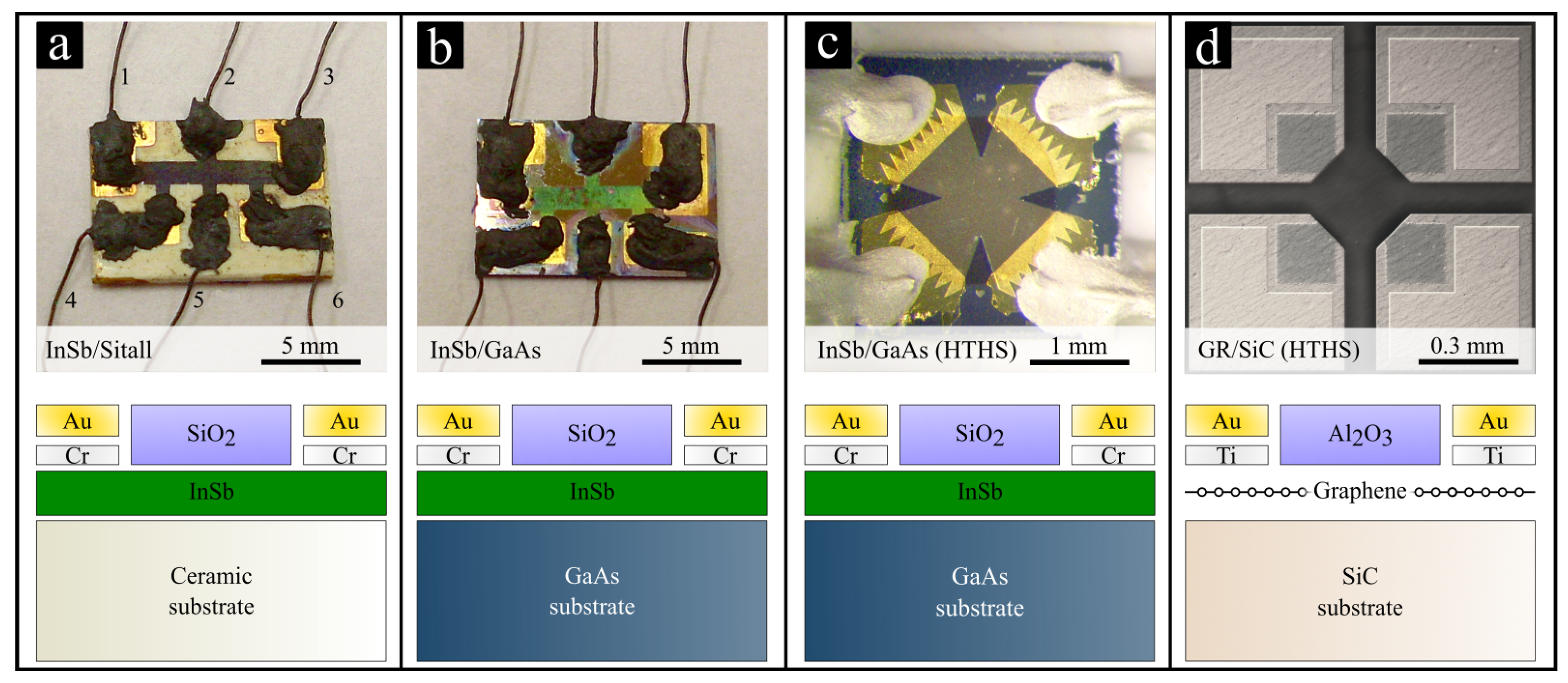
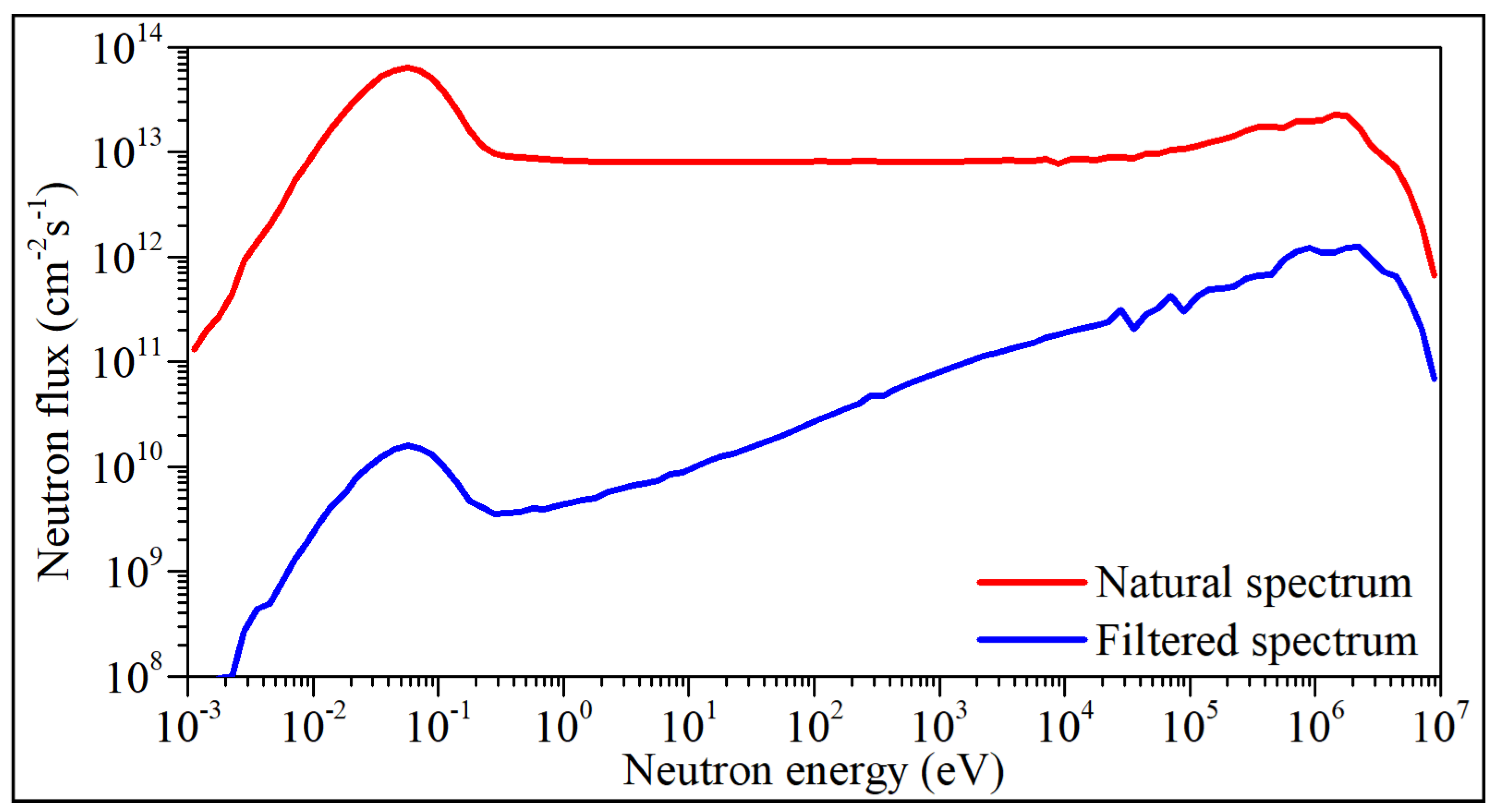
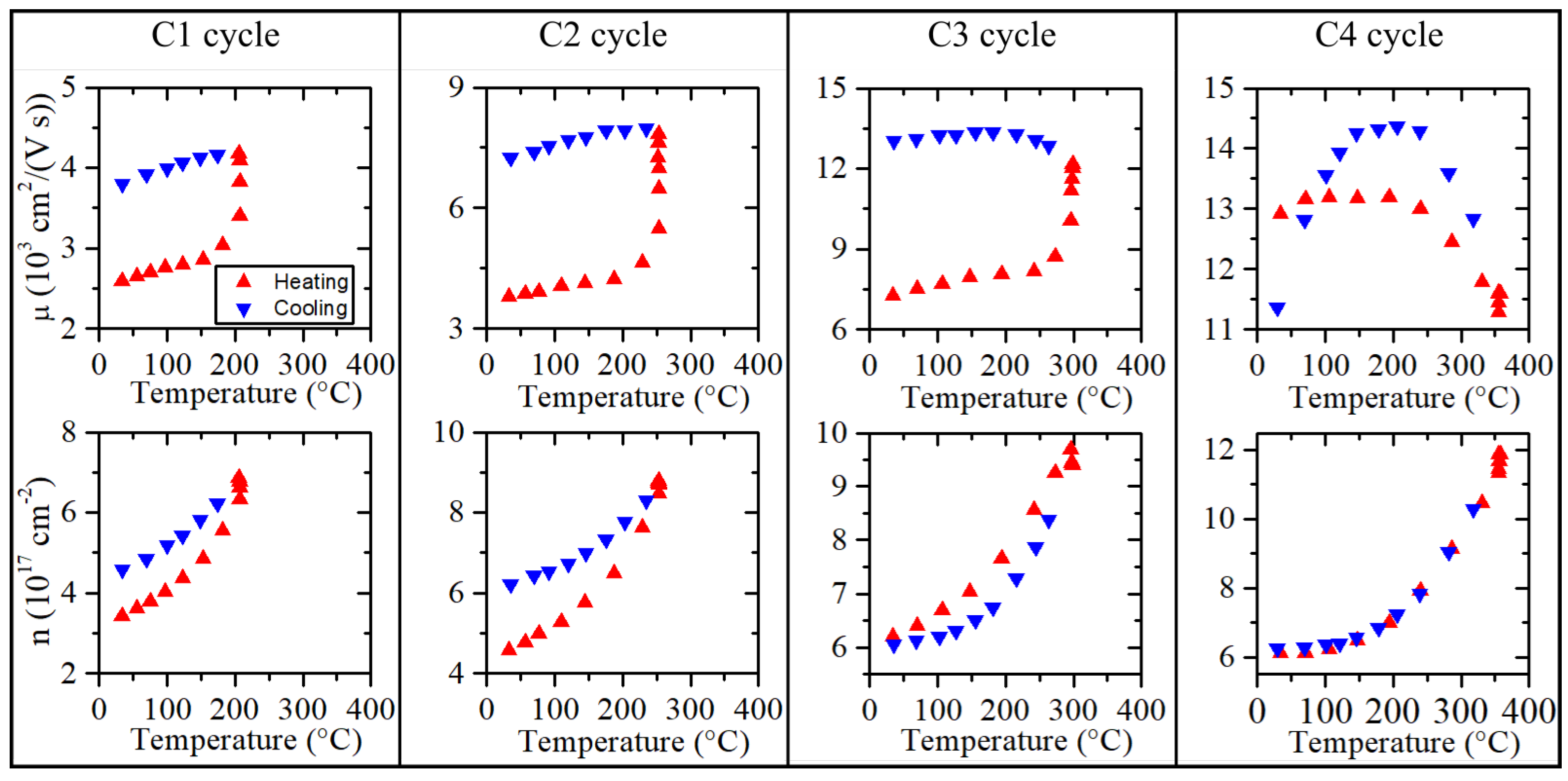

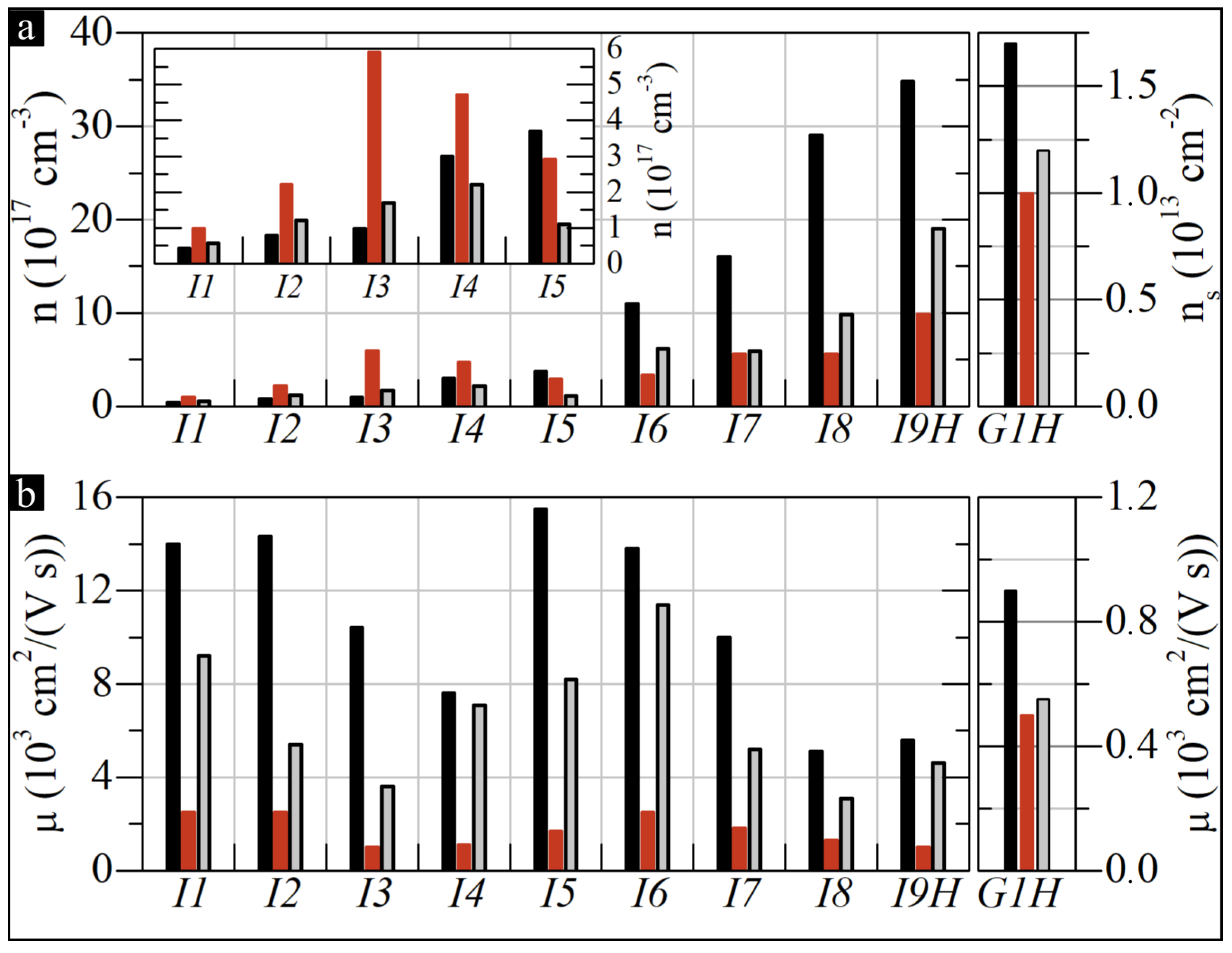

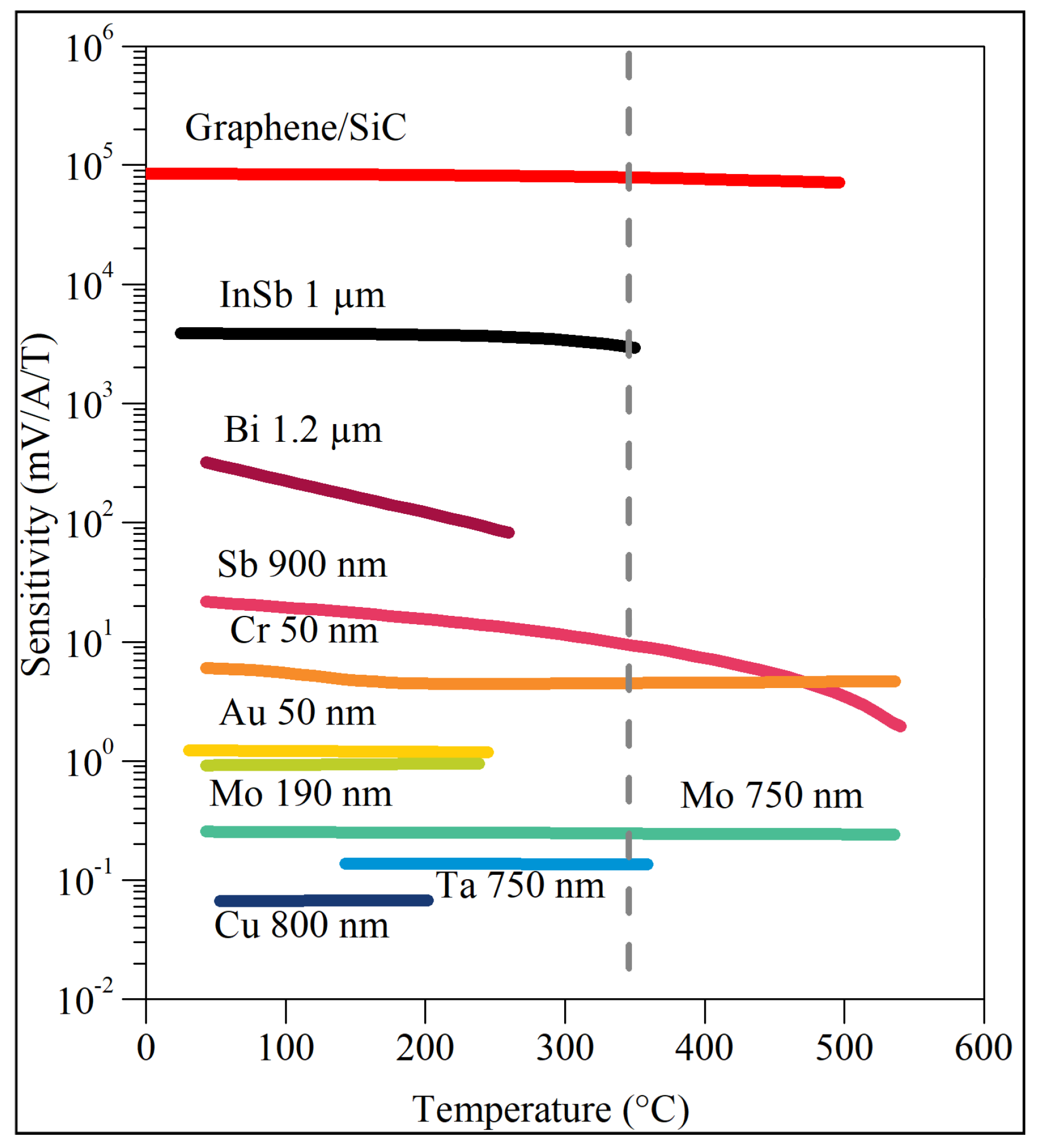
| InSb Sample No. <Dopant> Substrate | Film Thickness m | Carrier Mobility | % | Carrier Density n | % | |
|---|---|---|---|---|---|---|
| I1 <-> GaAs | 4.5 | A | 14,000 | - | 0.42 | - |
| B0 | 2500 | −82 | 0.97 | 131 | ||
| B1 | 8100 | −42 | 1.36 | 224 | ||
| B2 | 9200 | −34 | 0.57 | 36 | ||
| I2 <-> Sitall | 2.0 | A | 14,300 | - | 0.78 | - |
| B0 | 2500 | −83 | 2.20 | 182 | ||
| B1 | 12,200 | −15 | 1.65 | 112 | ||
| B2 | 5400 | −62 | 1.20 | 54 | ||
| I3 <-> Sitall | 2.0 | A | 10,400 | - | 0.98 | - |
| B0 | 1000 | −90 | 5.90 | 502 | ||
| B1 | no measurement | - | no measurement | - | ||
| B2 | 3600 | −65 | 1.70 | 73 | ||
| I4 <Te> Sitall | 1.7 | A | 7600 | - | 3.00 | - |
| B0 | 1100 | −86 | 4.70 | 57 | ||
| B1 | no measurement | - | no measurement | - | ||
| B2 | 7100 | −7 | 2.20 | −27 | ||
| I5 <Te> Sitall | 2.0 | A | 15,500 | - | 3.70 | - |
| B0 | 1700 | −89 | 2.90 | −22 | ||
| B1 | 13,000 | −16 | 2.05 | −45 | ||
| B2 | 8200 | −47 | 1.10 | −70 | ||
| I6 <Se> Sitall | 3.1 | A | 13,800 | - | 11.00 | - |
| B0 | 2500 | −82 | 3.30 | −70 | ||
| B1 | 13,000 | −6 | 6.06 | −45 | ||
| B2 | 11,400 | −17 | 6.20 | −44 | ||
| I7 <Sn> GaAs | 1.0 | A | 10,000 | - | 16.00 | - |
| B0 | 1800 | −82 | 5.60 | −65 | ||
| B1 | 3600 | −64 | 5.83 | −64 | ||
| B2 | 5200 | −48 | 5.90 | −63 | ||
| I8 <Sn> GaAs | 1.1 | A | 5100 | - | 29.0 | - |
| B0 | 1300 | −75 | 5.60 | −81 | ||
| B1 | 2100 | −59 | 7.33 | −75 | ||
| B2 | 3100 | −39 | 9.80 | −66 | ||
| I9H <Sn> GaAs | 1.0 | A | 5600 | - | 34.80 | - |
| B0 | 1000 | −82 | 9.80 | −71 | ||
| B1 | 3700 | −34 | 16.20 | −53 | ||
| B2 | 4600 | −18 | 19.00 | −45 | ||
| GR/SiC sample no. substrate | carrier mobility cm/(Vs) | % | sheet carrier density n 10 cm | % | ||
| G1H <monolayer> 4HSiC | A | 900 | - | 1.70 | - | |
| B0 | 500 | −43 | 1.00 | −39 | ||
| B1 | 520 | −42 | 1.12 | −34 | ||
| B2 | 550 | −40 | 1.20 | −30 |
| Material | Reactor Type | Neutron Fluence | Optimal n | Change, % | °C |
|---|---|---|---|---|---|
| InSb [43,44] | IBR-2 | (1–3) | 25 | ||
| InSb [45] | IBR-2 | (1.1) | 6.7 | <1 | 17 |
| InSb [46] | IBR-2 | – | 0.03–1 | <70 | |
| InSb [45,47] | IBR-2 | (0.7–3.1) | 6.4 | <1 | 17 |
| InSb [48] | IBR-2 | (6–7) | 0.01 | ||
| InSb [49] | WWR-2 | (4–6) | <40 | 110 | |
| InSb [14] | MARIA * | (0.9–1.2) | n/c | 100 | <200 |
| InSb [15] | LVR-15 | n/c | <3 | n/c | |
| InSb [45] | LVR-15 | n/c | 6–23 | 90 | |
| InSb [45] | LVR-15 | (0.3–1.3) | n/c | 7–30 | 90 |
| Bi [9] | LVR-15 | n/c | 1.3 | 100 | |
| Sb [11,13] | - | n/c | n/c | n/c | n/c |
| Cr [5] | - | n/c | n/c | n/c | n/c |
| Au [50] | IBR-2 | – | n/c | <3 | 130 |
| Mo [42] | - | n/c | n/c | n/c | n/c |
| Ta [42] | - | n/c | n/c | n/c | n/c |
| Cu [42] | - | n/c | n/c | n/c | n/c |
| Graphene ** [17] | IBR-2 | (0.1–1.5) | n/c | 3 | 55 |
Publisher’s Note: MDPI stays neutral with regard to jurisdictional claims in published maps and institutional affiliations. |
© 2022 by the authors. Licensee MDPI, Basel, Switzerland. This article is an open access article distributed under the terms and conditions of the Creative Commons Attribution (CC BY) license (https://creativecommons.org/licenses/by/4.0/).
Share and Cite
El-Ahmar, S.; Przychodnia, M.; Jankowski, J.; Prokopowicz, R.; Ziemba, M.; Szary, M.J.; Reddig, W.; Jagiełło, J.; Dobrowolski, A.; Ciuk, T. The Comparison of InSb-Based Thin Films and Graphene on SiC for Magnetic Diagnostics under Extreme Conditions. Sensors 2022, 22, 5258. https://doi.org/10.3390/s22145258
El-Ahmar S, Przychodnia M, Jankowski J, Prokopowicz R, Ziemba M, Szary MJ, Reddig W, Jagiełło J, Dobrowolski A, Ciuk T. The Comparison of InSb-Based Thin Films and Graphene on SiC for Magnetic Diagnostics under Extreme Conditions. Sensors. 2022; 22(14):5258. https://doi.org/10.3390/s22145258
Chicago/Turabian StyleEl-Ahmar, Semir, Marta Przychodnia, Jakub Jankowski, Rafał Prokopowicz, Maciej Ziemba, Maciej J. Szary, Wiktoria Reddig, Jakub Jagiełło, Artur Dobrowolski, and Tymoteusz Ciuk. 2022. "The Comparison of InSb-Based Thin Films and Graphene on SiC for Magnetic Diagnostics under Extreme Conditions" Sensors 22, no. 14: 5258. https://doi.org/10.3390/s22145258






